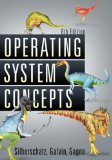“Operating System Concepts” by Abraham Silberschatz, Peter Galvin and Greg Gagne is a text-book that teaches the basics of operating systems design. As is implied by the title, the book focuses more on the concepts than their implementation. Almost all the concepts that you need to know to appreciate the working of an operating system are explained here and illustrated with numerous case studies.
The book covers all the operating systems concepts that you find in a standard text-book like process management, memory management, concurrency control, device management, etc. Unlike some of the other text-books, it also covers security, networking, distributed systems, etc. This makes the book slightly bulky, though it also makes it a comprehensive reference on the topic for beginners. A couple of chapters towards the end bring it all together by taking a detailed look at Linux and Windows XP. The book's web-site provides additional appendices on BSD Unix, Mach and Windows 2000.
The biggest criticism I have for this book as a computer programmer is
that it only covers the concepts, not their implementation. While it is
true that most of us will never ever implement an operating system, it
is my experience that only by looking at and tinkering with working
code do we programmers gain a solid understanding of a system. When you
look at the code you realise that it does not take black magic to write
an operating system. The tinkering of fearless programmers with such code
creates a breeding ground for fresh breakthroughs in this field - after
all, Linux is the result of such tinkering by a very talented hacker.
This focus on implementation is what makes “Operating
Systems Design and Implementation” by Andrew Tanenbaum such a valuable book when compared
to this book.
This book has gone through several editions over the years, gaining a couple of co-authors and losing one. It refrains from passing judgement over design alternatives. The language is simple and non-condescending. Some of the topics should perhaps have been dropped and some moved to an “advanced” text-book. For example, the chapters on networking, transaction processing and distributed systems really belong to other text-books devoted to the respective subjects.
If you are looking for a refresher text-book on operating systems or if you are just casually interested in operating systems design, this is a good book to have. If you are more serious, you will need to supplement this book with reading code from a real operating system like Linux or FreeBSD.
